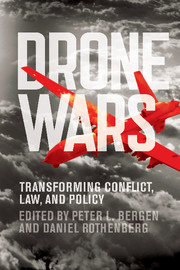Book contents
- Frontmatter
- Contents
- Contributors
- Acknowledgments
- Introduction
- Part I Drones on the Ground
- Part II Drones and the Laws of War
- Part III Drones and Policy
- Part IV Drones and the Future of War
- 17 No One Feels Safe
- 18 “Drones” Now and What to Expect Over the Next Ten Years
- 19 From Orville Wright to September 11
- 20 Drones and the Dilemma of Modern Warfare
- 21 How to Manage Drones
- 22 Drones and the Emergence of Data-Driven Warfare
- Index
- References
21 - How to Manage Drones
Transformative Technologies, the Evolving Nature of Conflict, and the Inadequacy of Current Systems of Law
Published online by Cambridge University Press: 05 December 2014
- Frontmatter
- Contents
- Contributors
- Acknowledgments
- Introduction
- Part I Drones on the Ground
- Part II Drones and the Laws of War
- Part III Drones and Policy
- Part IV Drones and the Future of War
- 17 No One Feels Safe
- 18 “Drones” Now and What to Expect Over the Next Ten Years
- 19 From Orville Wright to September 11
- 20 Drones and the Dilemma of Modern Warfare
- 21 How to Manage Drones
- 22 Drones and the Emergence of Data-Driven Warfare
- Index
- References
Summary
Drones, Law, and Emerging Technologies
Drones lie on the difficult border of three different conceptual domains: emerging technologies, the evolving nature of conflict, and the laws of war. The first two are characterized by extraordinary and growing complexity and the third is a reasonably well-understood and fairly carefully defined policy and legal framework. Within the domain of the laws of war, also known as international humanitarian law, drones do not engage issues of complexity within the system, but rather raise questions as to whether this important discourse and practice is still viable. That is, to what degree do drones lead us to a radical reconceptualization of the laws of war given foundational changes in technology and the nature of conflict? Rather than consider drones as a specific element of war, which is how they are usually addressed, we should consider them through a lens through which the future can be glimpsed, presenting us with ideas and challenges that extend beyond the demands of a single technology system.
Technological innovation, military operations and practice, and their broader social and cultural impacts, have been co-evolving throughout history. This process is often obvious: stirrups and composite bows privileged horse warriors such as those from the Eurasian steppes; corned gunpowder, developed by Europeans in the late fourteenth century, offered far better performance than black powder; cast cannons mounted on ships favored European navies during their global imperialist expansion; nuclear weapons made some kinds of war too awful to rationally contemplate but provided certain strategic advantages to nations that controlled them. However, most military technologies with transformative power have also had profound cultural implications. Gunpowder and cannon technology, for example, not only shifted the power relationship between infantry and heavy cavalry (knights), but, also, because of the logistic and administrative scale required to mount a campaign using them, privileged larger political and economic powers over smaller entities.
- Type
- Chapter
- Information
- Drone WarsTransforming Conflict, Law, and Policy, pp. 421 - 440Publisher: Cambridge University PressPrint publication year: 2014
References
- 1
- Cited by



